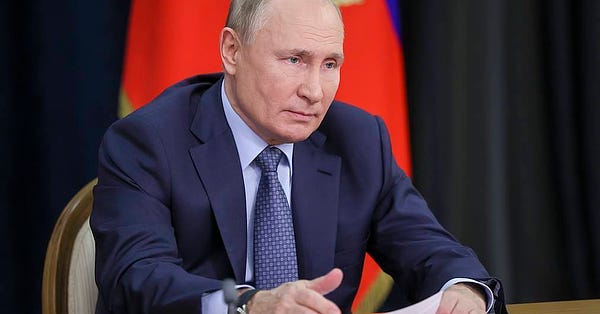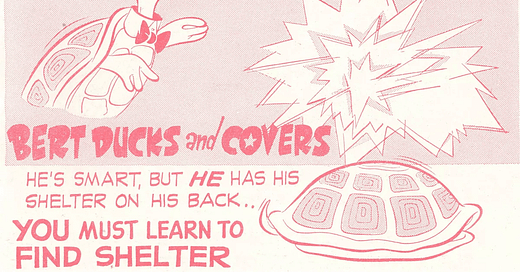Will Russia use nuclear weapons? Vladimir Putin recently hinted at the possibility that Russia could use nuclear weapons to further its goals in Ukraine. Although it is not the first time that Russia has threatened the possibility of nuclear war, it shouldn’t be discounted as entirely cheap talk. The risk of nuclear war is almost certainly elevated because of the current crisis. A broad exchange of nuclear weapons between Russia and NATO is still unlikely, but there is real chance Putin could use a nuclear weapon if he doesn’t feel he has any good options.
Before invading Ukraine, Vladimir Putin made a point of noting Russia is “one of the most powerful nuclear states”. He warned that anyone who tried to interfere with Russia would face consequences “such as [they] had never experienced in [their] entire history”. It sounded a lot like a threat. On Sunday, after massive sanctions had been announced against Russia, Putin declared—in a bizarre televised meeting—he was ordering Russian deterrent forces to begin a “special regime of combat duty alert”. It’s unclear what that means, but the US said that it wasn’t changing the posture of its own nuclear forces. When asked whether Americans should be worried about the risk of nuclear war, President Biden simply said, “No.”


We should be at least *somewhat* worried about the risk of nuclear war. A simple way of estimating the likelihood of something is to look at how often similar things have happened in the past. This type of “base rate” calculation is probably of limited use in estimating nuclear war risk, in part because there are good reasons to think the risk of nuclear war varies widely depending on the geopolitical situation at any given time. But it’s useful as a first approximation. In the 72 years since more than one country has had nuclear weapons—the era of nuclear deterrence—no nuclear weapons have been used against human beings. In 2018, Good Judgment superforecasters—including me—estimated that at the time the risk a nuclear attack by a state actor would kill at least one person was about 0.4% a year.1
Of course, the risk of nuclear war is probably much higher during periods of international crisis. I was a co-author of a Global Catastrophic Risk Institute paper on the probability of nuclear war that identified two main paths to nuclear war: 1) an intentional first strike and 2) an “inadvertent” strike triggered by the incorrect belief the other side had already launched a first strike. Crises like the invasion of Ukraine increase the risk of both scenarios. It increases the risk of a first strike because one side might calculate that it will give them an advantage in the conflict. It increases the risk of an inadvertent war because higher alert levels lower the threshold for a response to a perceived attack. In periods of relative peace, the risk of inadvertent nuclear war seems like the greater risk. But our paper identified a number of times when a state appeared to threaten or consider the use of nuclear weapons—including in 2015 when Putin supposedly considered placing Russia’s nuclear forces on alert in order to protect Russia’s “historical territory” in Crimea.2
One reason to think Putin is unlikely to order a nuclear attack on Ukraine or against NATO is that it is hard to see what he would achieve by doing so. An attack on NATO would probably not win him any concessions and could trigger a catastrophic war with no winners. A nuclear attack on Ukraine—a country with which Russians have a strong affinity—could turn his own people against him. But if we had made a similar argument that Russia was unlikely to do a full-scale invasion of Ukraine—as I did—we would have been wrong. With a large part of the world arrayed against him, Putin doesn’t have many good options and doesn’t seem to have many inhibitions. If he feels cornered, he might lash out in spite of the consequences. As Fiona Hill told Politico, “Every time you think, ‘No, he wouldn’t, would he?’ Well, yes, he would.”

So how worried should we be? I think the risk of a miscalculation resulting in an inadvertent war is higher than it is at times of relative peace, but I still think it’s fairly low because NATO appears to be taking care to minimize the risk. In spite of all the apparent close calls in history, none of them actually did lead to nuclear war. I think for similar reasons a major exchange of nuclear weapons between Russia and NATO is unlikely. But unfortunately I don’t think we can rule out Putin deciding to order a more limited nuclear strike if he doesn’t feel he has any good options.
My Forecast:
4% chance Russia kills at least one person using a nuclear weapon before July 1
Listen to Atief Heermance, Scott Eastman, and I talk about the invasion of Ukraine with superforecaster Balkan Devlen on the NonProphets podcast here. Clay Graubard’s summary of Ukraine conflict forecasts—including forecasts about nuclear weapons use—is here.
Luisa Rodriguez, “How Likely is a Nuclear Exchange Between the US and Russia,” Effective Altruism Forum (June 19, 2019).
Seth D. Baum, Robert de Neufville, and Anthony M. Barrett, “A Model For The Probability Of Nuclear War,” Global Catastrophic Risk Institute Working Paper 18-1 (2018).




4% is very concerning, I think. It means everyone who can afford it and is currently living in the Northern hemisphere should go south (Australia/Chile?) right now, immediately, until the war is over.